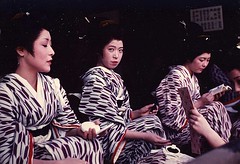Geisha originated as skilled professional entertainers; originally most were male. Geisha used their skills in traditional Japanese arts, music, dance, and storytelling. Town (machi) geisha worked freelance at parties outside the various pleasure quarters, while quarter (kuruwa) geisha entertained at parties within the pleasure quarters. As the artistic skills of high-ranking courtesans declined, the skills of the geisha, who were both male and female, became more in demand, according to wikipedia.org.
As a profession, they are entertainers and conversationalists, much like professional ballet dancers, classical musicians, or party emcees. They do give public concerts, but the majority of their business is in private engagements. Depending on what hanamachi they work in, their "gei" specialty differs. There are geisha who dance, geisha who play shamisen, and geisha who do both. Their clientele are most often businessmen, those with an appreciation for the classical arts and with money enough to pay for the expensive fees.
Traditionally, they began their training at a very young age. Most girls were sold to geisha houses ("okiya") as children, and began their training in various traditional arts almost immediately. The only exception were the daughters of geisha, who were brought up as geisha themselves, usually as the successor ("atotori" or "musume-bun") to the okiya.
The first stage of training was called shikomi. When girls first arrived at the okiya, they would be put to work as maids. The work was difficult with the intent to "make" and "break" the new girls. The most junior shikomi of the house would have to wait late into the night for the senior geisha to return from engagements, sometimes as late as two or three in the morning. During this stage of training, the shikomi would go to classes at the hanamachi's geisha school. In modern times, this stage still exists, mostly to accustom the girls to the traditional dialect, traditions and dress of the "karyūkai".
Once the recruit became proficient with the geisha arts, and passed a final, nerve-wrecking dance exam, she would be promoted to the second stage of training: minarai. Minarai do not do any housework; they can be hired for parties, but at significantly reduced fees. Minarai generally work closely with a particular tea house, learning from the "okaa-san" (the "mother" figure of their house) the techniques not taught in school, such as conversation and games. This stage lasts only about a month.
After a short period of time, the third (and most famous) stage of training began, called maiko. Maiko are apprentice geisha, and this stage can last for years. Maiko learn from their senior geisha mentor ("onee-san" meaning "older sister") and follow them around to all their engagements. The onee-san/imoto-san (junior) relationship is extremely important. Since the onee-san teaches her maiko everything about working in the hanamachi, her teaching is vital. She will teach her proper ways of serving tea, playing shamisen, and dancing, the casual talk of conversation, which is also important of a maiko to learn for future invitations to more teahouses and gatherings. One would suggest that geisha are prone to "flirt", but it is only their nature to seem demure and innocent. The onee-san will even help pick the maiko's new professional name, which is only one word, similar to raqs sharqi that while have one kanji or symbol related to her own name. Maiko are the flamboyantly dressed geisha most pictures of hanamachi show.
After a period as short as six months (in Tokyo) or as long as five years (in Kyoto), the maiko is promoted to geiko, which is a full-fledged geisha. Geiko charge full price for their time. Geisha remain geiko until they retire.
Wednesday, January 10, 2007
Subscribe to:
Post Comments (Atom)


No comments:
Post a Comment